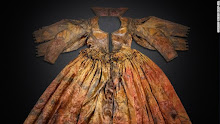The wedding
celebration of Prince Henry of Wales and “princess-to-the-whole-world” Ms. Meghan
Markle was truly a “Windsor knot” of love and diversity, beauty and harmony,
inclusion and passion, acted out on a world stage in perfect archetypal timing as
only old souls on a spiritual mission can do. Lighting up the world for the
rest of us!
I was
touched by the news a few days before the wedding about the gracious gesture by
the Prince of Wales (Harry’s beloved father and future king) accepting Meghan’s
invitation, in the absence of her own father, to be her bridal escort. And it
played out even more beautifully and mythically than could be imagined.
Meghan,
confidently and joyfully on her own, entered St. George’s Chapel to the sound
of trumpets on a sunlit noontime, carrying a small, sentimental bouquet of forget-me-nots
and other delicate flowers picked by her groom the morning before in the
gardens of Kensington Palace (where his late mother had lived and he now made a
home with Meghan.) The radiant bride, in designer-sculpted shimmering white silk
and the most feminine filigree diamond tiara—“something old and something borrowed”
from the Queen—began her walk down the aisle as the voice of a lyrical soprano
lifts in “light divine and glory” with two delighted pageboys holding up her floral-embroidered,
nod-to-the-monarchy, long silk veil.
As Prince
Charles met her under the archway marking the end of the nave—lush with locally-gathered
greenery and white flowers—offering his arm to escort Meghan through the Quire
and the rest of the journey to the altar to stand beside his youngest son (“Thank
you, Pa,” Harry acknowledges with a smile), it was as though the grand old
patriarchy was bowing to the young goddess, honoring her lineage, and
delivering her safely and gallantly to the far shore, where she would then help
ignite a new world that genuinely knows of love.
Of course,
the imagery of Meghan, a successful woman of experience and substance, self-assuredly
walking down the aisle alone on her wedding day could be taken as a bold feminist
statement, especially for a royal wedding—needing no one to hold her up, give
her away, or speak for her—so any action otherwise would simply have been an
outdated tradition. (Although an escort, how I consider it, could be
appropriately offered, just as it was, as an act of courtesy and respect.)
Nonetheless, what truly struck me as the defining moments of the day were these
archetypal gestures by kindly menfolk: offering their attendant arm, handpicked
flowers, and pure exuberance. The father, the groom, the boys; the past, the
present, the future—giving of themselves in the most respectful, tender, even
reverent way. After all, on some level I would wager, they knew this fresh wave
of feminine consciousness now sweeping the world is the future we all long
for...and this day represented its promise in every expression. There was
something much deeper brewing here.
And the
preacher-man got there—right down into the heart of the matter: the redeeming
power of love! Quoting Dr. Martin Luther King, Jr., the Most Reverend Michael
Bruce Curry, who traveled to Windsor from Chicago, declared that “love is the
only way.” With soulful hand-gesturing passion, he reminded the audience (even
the upper-crust British members, perhaps accustomed to their less emotional,
don’t-knock-tradition way of doing things): “We must discover the power of
love, the redemptive power of love. And when we do that, we will make of this
old world a new world. Love is the only way.” Going off-script, he mentioned
some of the most horrific practices of the old patriarchy that denied love in
the world—and had us squirming in our seats! But how else do you stir up the
resistance, re-ignite the revolution, awake the ‘unwoke’ to the power of love?
Harry and
Meghan are on a mission, accepting each other’s wedding request to “stand by
me” as they lead their power-of-love
revolution, taking on nothing less than changing the world. Their wedding-day
ceremony, a reflection of their own mixed histories, included archbishops and reverends
from various religions; guests from all backgrounds and locations; music from classical
British composers, an American bluesman and a Welsh deacon—there were hymns, an
orchestra and a gospel choir; readings from the Song of Solomon—the most
sensuous of biblical references; a teenage cellist from Nottingham playing like
an old master in the midst of royal Medieval heritage; there were the ancient
and the possible. This gleaming day also included lots of handholding, “a room
full of happiness,” and fiery love prophets; a proud and teary, independent,
free-spirited mother-of-the bride as well as the fragrance of white garden
roses arranged in memory of the groom’s own unforgettable mother. Then there
were those gentlemanly gestures in honor of the emerging modern woman and the
legacy she represents. There is indeed something deeper brewing here and we are
all invited to the love revolution! ~









































